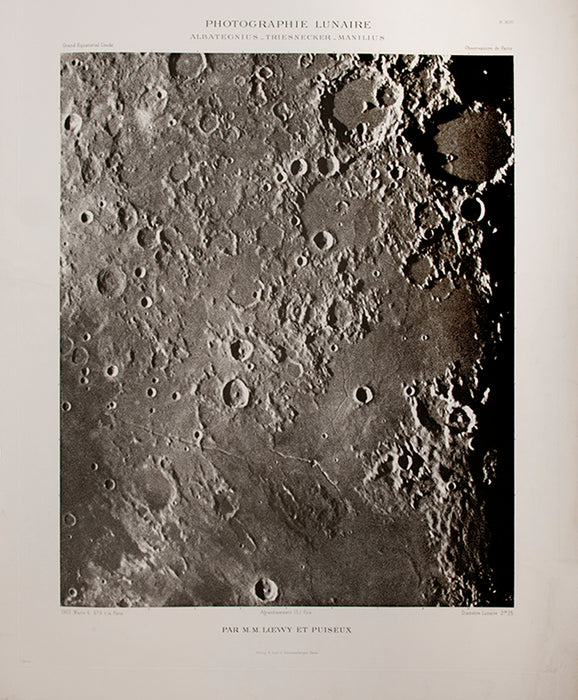
Photographie Lunaire. Albategnius_Triesnecker_Manilius. Pl. XLVI.
Paris, Imprimerie Nationale, 1899-1910.
The Atlas photographique de la lune was the ultimate achievement of nineteenth century astronomical photography and can be regarded, along with Muybridge's Animal Locomotion (1887) and Edward S. Curtis' The North American Indian (1907-30), as one of the great publishing ventures of the nineteenth and early twentieth centuries. Indeed it was not until the 1970's when Bernard Lyot at the Pic du Midi Observatory obtained results that were clearly better than those of Loewy and Puiseux. As with all books published in fascicles, complete copies are rare and the individual plates, amongst the largest and finest ever made, are prized by collectors for their sheer aesthetic beauty.
Moritz Loewy (1833-1907) and Pierre-Henri Puiseux (1855-1928), assisted by Charles Morvan, undertook a project to make a complete series of detailed photographs of the moon and the lunar surface. The two astronomers devoted approximately 500 evenings to observations in order to make more than 6,000 photographs of the moon. Their very best images were then published in L'Atlas photographique de la Lune. This was issued in fascicles from 1896 and 1910 by the Observatory of Paris, the atlas represents the best and most complete overview of the work of Loewy and Puiseux.
The photographs were taken through the 24-inch coudé refractor, which had been invented by Loewy in 1889. The negatives were produced at the Paris Observatory with a camera attached to a telescope. Since the earth and the moon are moving constantly, the camera and telescope had to move accordingly to produce a clear image-no easy feat considering the long exposure times required to take photographs at night. Both were synchronised with the moon's path by a sophisticated preset clock system, and the resulting images, such as this example, maintained an impressive amount of detail, even after subsequent photographic enlargement and transfer to an etching plate.
The majority of the photographic reproductions by héliogravure were entrusted to M. Fillon at Heuse, Gaultier and Schutzenberger. The enlargements were used to decorate the showroom of the Ministère de l'Instruction Publique at the Exposition Universelle during the World's Fair, which was held in Paris in 1900.
Héliogravure after photographs by Loewy and Puiseux depicting the Moons surface, from the work "Atlas Photographique de la Lune". Some light dust-soiling, otherwise good.
Provenance
Delivery
We offer secure and express delivery on all local and international orders of rare books, maps and prints placed through this website.










